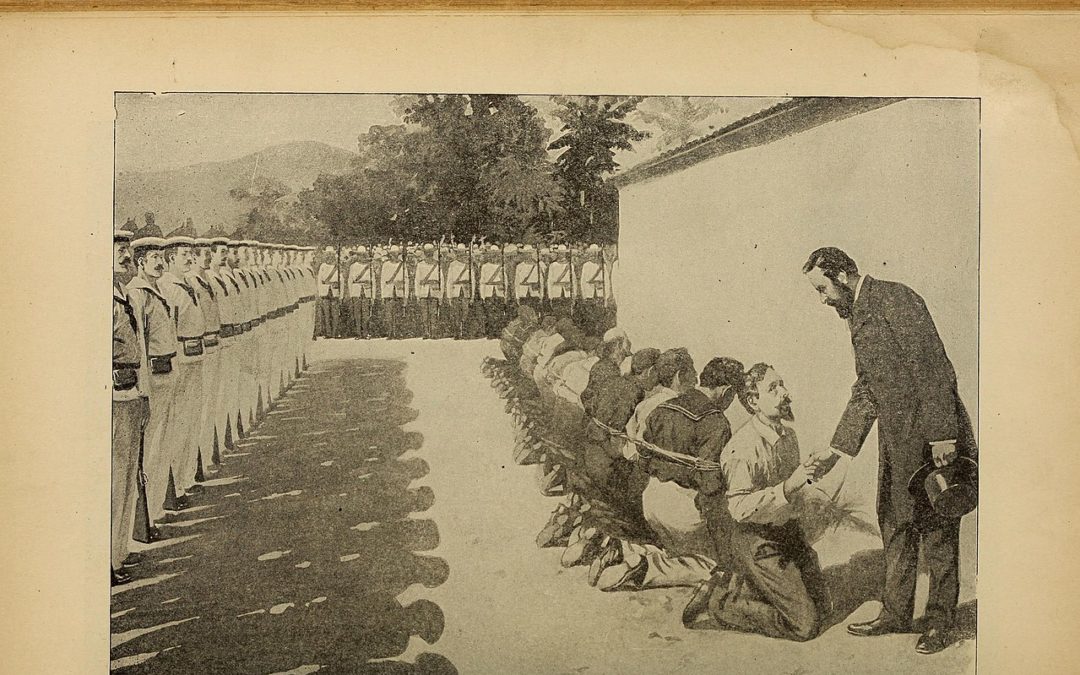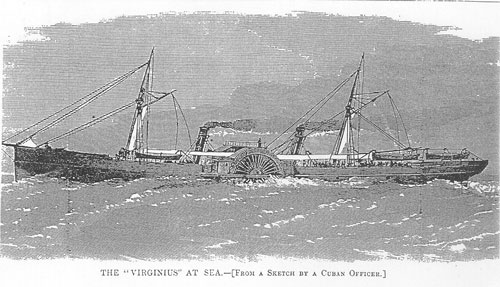
Following the Civil War, the United States Navy had languished as funding was diverted to efforts aimed at rebuilding a wounded nation. Only a small handful of ships were kept to serve as a coastal defense force. Elsewhere, nations had observed the power of Ironclads during the Civil War and hastily began building fleets of iron plated warships. Somewhat Ironically, the United States had largely abandoned the development of the ironclad following the War. While they relied on leftovers from the Civil War, other nations began introducing more advanced ironclad models. This caused the United States to fall behind in quality as well as quantity. The United States needed a reminder that the Navy was an important component in strengthening the country. That reminder would come in the 1870s when the country found itself at odds with Spain during the Virginius affair.
53 people were executed with several then being decapitated while the bodies were trampled under horses.
HMS Niobe was a "Screw-Slope" design like the ship pictured above.
Fortunately, the British Government had become aware of what was happening and dispatched a warship to Cuba to investigate. The warship, HMS Niobe, arrived at the city of Santiago where the executions were taking place. The commander of the ship, Sir Lambton Loraine, immediately ordered the Spanish to cease the executions. Loraine even went so far as to threaten to bombard the city if his demands were not met. Spain relented and halted the executions, sparing the surviving crew of the Virginius.
The United States public, upon learning of the executions, immediately began calling for war against Spain. Luckily, the United States Government was able to diplomatically resolve the crisis. They secured reparations for the victims as well as the return of Virginius and her crew. This victory in diplomacy served to quell public anger and prevent the out brake of further hostility.
While the American public was demanding war, the United States Navy was no doubt dreading the prospect. At the time, a Spanish ironclad was in New York Harbor awaiting repairs. A more modern ironclad, the United States Navy had no warship in its inventory capable of engaging it. This led to the sickening realization that if war had broken out, the Spanish warship could have begun shelling New York City with impunity, the US Navy powerless to stop it. Had Spain sent its fleet to battle, the US Navy would be fighting an enemy with a larger number of more advanced ships. The US Navy was surpassed by Spain both in quality and quantity. To make matters worse, the few warships the United States had were incapable of fighting abroad
U.S.S Manhattan, an example of a Civil War Era Ironclad that was retained for postwar service through the 1880's.
While diplomacy was hailed as the driving force that settled the Virginius Affair, the US Government no doubt noted the effect that gunboat diplomacy had in preventing further executions. Spain had continued executing captives despite demands by the United States. The executions only stopped when a British warship arrived and issued a threat that Spanish authorities could not ignore. Military power had succeeded where diplomacy had not. The United States must have realized the weight of power a blue water fleet would provide on the negotiating table.
Luckily, the lessons of the Virginius Affair had not gone unnoticed. George M. Robeson, then serving as the Secretary of War, determined that the United States Navy must begin rebuilding itself into a more capable force. He immediately began calling for a new fleet of warships capable of matching those found in foreign navies. However, he faced stiff opposition from the United States Congress. Through clever tricks and outright deception, Robeson would eventually get his fleet. His efforts laid the groundwork that saw the United States Navy rise from a poorly equipped coastal defense force into a large, modern blue water navy able to project United States power abroad.
When the Virginius affair first broke out, a Spanish ironclad—the Arapiles—happened to be anchored in New York Harbor for repairs, leading to the uncomfortable realization on the part of the US Navy that it had no ship capable of defeating such a vessel. US Secretary of War George M. Robeson
U.S.S Puritan in action during the Spanish American War in 1898
believed a US naval resurgence was necessary. Congress hastily issued
contracts for the construction of five new ironclads, and accelerated
its existing repair program for several more.USS Puritan and the four Amphitrite-class monitors were subsequently built as a result of the Virginius war scare.All five vessels would later take part in the Spanish–American War of 1898.
Amphitrite Class Monitor U.S.S Monadnock crossing the Pacific on the way to the Philippines





That was a sad time in the Navy...
ReplyDeleteThat was a sad time in the Navy...
ReplyDeleteHey Old NFO;
DeleteSame for the Army and it took the Apanish American War to realize it.